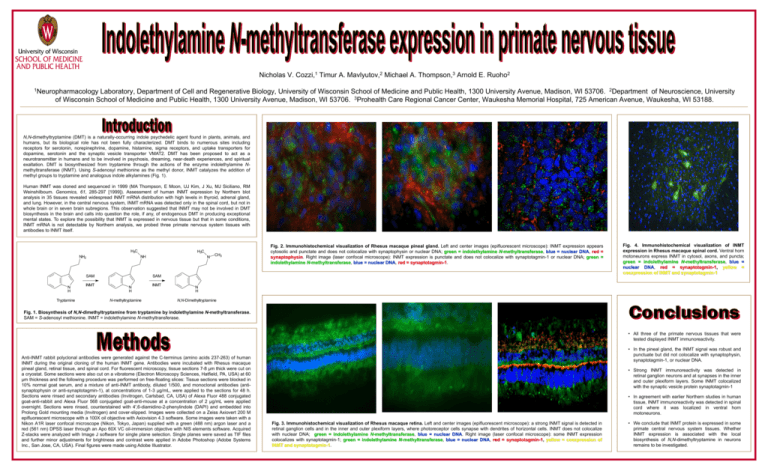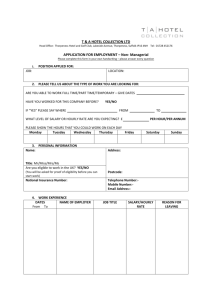indolethylamine N-methyltransferase
advertisement

Nicholas V. Cozzi,1 Timur A. Mavlyutov,2 Michael A. Thompson,3 Arnold E. Ruoho2 1Neuropharmacology Laboratory, Department of Cell and Regenerative Biology, University of Wisconsin School of Medicine and Public Health, 1300 University Avenue, Madison, WI 53706. 2Department of Neuroscience, University of Wisconsin School of Medicine and Public Health, 1300 University Avenue, Madison, WI 53706. 3Prohealth Care Regional Cancer Center, Waukesha Memorial Hospital, 725 American Avenue, Waukesha, WI 53188. N,N-dimethyltryptamine (DMT) is a naturally-occurring indole psychedelic agent found in plants, animals, and humans, but its biological role has not been fully characterized. DMT binds to numerous sites including receptors for serotonin, norepinephrine, dopamine, histamine, sigma receptors, and uptake transporters for dopamine, serotonin and the synaptic vesicle transporter VMAT2. DMT has been proposed to act as a neurotransmitter in humans and to be involved in psychosis, dreaming, near-death experiences, and spiritual exaltation. DMT is biosynthesized from tryptamine through the actions of the enzyme indolethylamine Nmethyltransferase (INMT). Using S-adenosyl methionine as the methyl donor, INMT catalyzes the addition of methyl groups to tryptamine and analogous indole alkylamines (Fig. 1). Human INMT was cloned and sequenced in 1999 (MA Thompson, E Moon, UJ Kim, J Xu, MJ Siciliano, RM Weinshilboum. Genomics, 61, 285-297 [1999]). Assessment of human INMT expression by Northern blot analysis in 35 tissues revealed widespread INMT mRNA distribution with high levels in thyroid, adrenal gland, and lung. However, in the central nervous system, INMT mRNA was detected only in the spinal cord, but not in whole brain or in seven brain subregions. This observation suggested that INMT may not be involved in DMT biosynthesis in the brain and calls into question the role, if any, of endogenous DMT in producing exceptional mental states. To explore the possibility that INMT is expressed in nervous tissue but that in some conditions, INMT mRNA is not detectable by Northern analysis, we probed three primate nervous system tissues with antibodies to INMT itself. H3C NH2 H3C NH SAM N H Tryptamine INMT N CH3 Fig. 2. Immunohistochemical visualization of Rhesus macaque pineal gland. Left and center images (epifluorescent microscope): INMT expression appears cytosolic and punctate and does not colocalize with synaptophysin or nuclear DNA; green = indolethylamine N-methyltransferase, blue = nuclear DNA, red = synaptophysin. Right image (laser confocal microscope): INMT expression is punctate and does not colocalize with synaptotagmin-1 or nuclear DNA; green = indolethylamine N-methyltransferase, blue = nuclear DNA, red = synaptotagmin-1. SAM N H N-methyltryptamine INMT Fig. 4. Immunohistochemical visualization of INMT expression in Rhesus macaque spinal cord. Ventral horn motoneurons express INMT in cytosol, axons, and puncta; green = indolethylamine N-methyltransferase, blue = nuclear DNA, red = synaptotagmin-1, yellow = coexpression of INMT and synaptotagmin-1 N H N,N-Dimethyltryptamine Fig. 1. Biosynthesis of N,N-dimethyltryptamine from tryptamine by indolethylamine N-methyltransferase. SAM = S-adenosyl methionine. INMT = indolethylamine N-methyltransferase. • All three of the primate nervous tissues that were tested displayed INMT immunoreactivity. Anti-INMT rabbit polyclonal antibodies were generated against the C-terminus (amino acids 237-263) of human INMT during the original cloning of the human INMT gene. Antibodies were incubated with Rhesus macaque pineal gland, retinal tissue, and spinal cord. For fluorescent microscopy, tissue sections 7-8 µm thick were cut on a cryostat. Some sections were also cut on a vibratome (Electron Microscopy Sciences, Hatfield, PA, USA) at 60 μm thickness and the following procedure was performed on free-floating slices: Tissue sections were blocked in 10% normal goat serum, and a mixture of anti-INMT antibody, diluted 1/500, and monoclonal antibodies (antisynaptophysin or anti-synaptotagmin-1), at concentrations of 1-3 μg/mL, were applied to the sections for 48 h. Sections were rinsed and secondary antibodies (Invitrogen, Carlsbad, CA, USA) of Alexa Fluor 488 conjugated goat-anti-rabbit and Alexa Fluor 568 conjugated goat-anti-mouse at a concentration of 2 μg/mL were applied overnight. Sections were rinsed, counterstained with 4',6-diamidino-2-phenylindole (DAPI) and embedded into Prolong Gold mounting media (Invitrogen) and cover-slipped. Images were collected on a Zeiss Axiovert 200 M epifluorescent microscope with a 100X oil objective with Axiovision 4.3 software. Some images were taken with a Nikon A1R laser confocal microscope (Nikon, Tokyo, Japan) supplied with a green (488 nm) argon laser and a red (561 nm) DPSS laser through an Apo 60X VC oil-immersion objective with NIS elements software. Acquired Z-stacks were analyzed with Image J software for single plane selection. Single planes were saved as TIF files and further minor adjustments for brightness and contrast were applied in Adobe Photoshop (Adobe Systems Inc., San Jose, CA, USA). Final figures were made using Adobe Illustrator. • In the pineal gland, the INMT signal was robust and punctuate but did not colocalize with synaptophysin, synaptotagmin-1, or nuclear DNA. • Strong INMT immunoreactivity was detected in retinal ganglion neurons and at synapses in the inner and outer plexiform layers. Some INMT colocalized with the synaptic vesicle protein synaptotagmin-1 • In agreement with earlier Northern studies in human tissue, INMT immunoreactivity was detected in spinal cord where it was localized in ventral horn motoneurons. Fig. 3. Immunohistochemical visualization of Rhesus macaque retina. Left and center images (epifluorescent microscope): a strong INMT signal is detected in retinal ganglion cells and in the inner and outer plexiform layers, where photoreceptor cells synapse with dendrites of horizontal cells. INMT does not colocalize with nuclear DNA; green = indolethylamine N-methyltransferase, blue = nuclear DNA. Right image (laser confocal microscope): some INMT expression colocalizes with synaptotagmin-1; green = indolethylamine N-methyltransferase, blue = nuclear DNA, red = synaptotagmin-1, yellow = coexpression of INMT and synaptotagmin-1. • We conclude that INMT protein is expressed in some primate central nervous system tissues. Whether INMT expression is associated with the local biosynthesis of N,N-dimethyltryptamine in neurons remains to be investigated.





